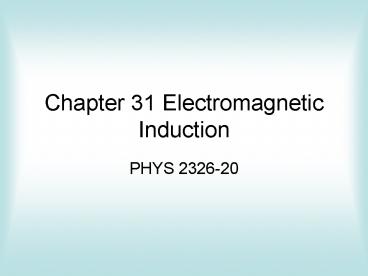Chapter 31 Electromagnetic Induction - PowerPoint PPT Presentation
1 / 19
Title:
Chapter 31 Electromagnetic Induction
Description:
Electric guitar pickup. Bicycle speedometer sensor. Electric transformer. Generator. Motional EMF ... An electric field is created in the conductor as a result ... – PowerPoint PPT presentation
Number of Views:230
Avg rating:3.0/5.0
Title: Chapter 31 Electromagnetic Induction
1
Chapter 31 Electromagnetic Induction
- PHYS 2326-20
2
Concepts to Know
- Magnetic Induction
- Induced Current
- Induced EMF
- Faradays law
- Lenzs Law
- Motional Electromotive Force
- Induced Electric Fields
- Eddy Currents
- Maxwells Equations
- Superconductivity (Chapter 27.5)
3
Faradays Law
- Faradays Law of Induction
- An induced EMF is produced by a changing magnetic
field.
4
Faradays Law
- Assuming a uniform field B at an angle ? to the
vector area A produces - EMF -d (BA cos ?)/dt
- Magnitude of B can change with time
- Area enclosed by loop can change with time
- Angle ? between B and A can change with time
- Any combination of the above
5
Examples
- Ground Fault Interruption detector
- Electric guitar pickup
- Bicycle speedometer sensor
- Electric transformer
- Generator
6
Motional EMF
- Given conductor of length l moving at velocity v
in magnetic field B - Electrons in conductor experience magnetic force
Fb downward creating a negative charge at the
bottom and a positive charge at the top and
creating a downward electric field E which
creates an upward force on electrons Fe
x
x
x
Fe
x
x
x
l
E
Fb
V
x
x
x
7
Motional EMF
- Charges accumulate until a balance is reached
where the upward force Fe qE balances with the
downward magnetic force on the electron Fb qvB
or E vB - Using the voltage relation ?V El for
equilibrium becomes ?V El Blv - ?V is potential but E is not electrostatic
- This En is an induced EMF
- It is maintained as long as the motion continues
8
Motional EMF
- The more general case for the induced EMF when v
B and l are not mutually perpendicular
9
Lenzs Law
- The induced current in a loop is in the direction
that creates a magnetic field that opposes the
change in magnetic flux through the area enclosed
by the loop
10
Induced EMF and Electric Fields
- An electric field is created in the conductor as
a result of the changing magnetic flux - Independence of test charges suggests that a
changing magnetic field generates an electric
field in empty space even without a conducting
loop - This is a nonconservative force
11
Eddy Currents
- According to Lenzs law currents are induced by a
changing magnetic flux. - Eddy currents are induced in bulk pieces of metal
moving through a magnetic field. - These are in the direction to create a magnetic
field to oppose the changes in the existing
magnetic field.
12
Maxwells Equations
- See chapter 34.2
- The basis of all electromagnetic phenomenon
13
Superconductivity
- R 0 below a critical temperature
- Once started current appears to flow indefinitely
and has been observed flowing for several years - How does one start a current flow?
- Remove a magnetic field
- Add a magnetic field such as lower a permanent
magnet down onto a plate until it balances
floating over the surface of the superconductive
plate
14
Example 1
- Given a coil of wire with 100 turns and a radius
of 5cm and a uniform magnetic field perpendicular
to the coil plane, an increasing field B with
rate 0.2T/s and a resistance of 50 0hms, find a)
the emf induced, d) the direction of the magnetic
field created by the coil, e) the power required
to keep the original field increasing by 0.2 T/s
in the z direction
15
Example 1
- r0.05m, N100, B (0.2T/s)t, R 50 O
- emf -N dFB /dt, FB is magnetic flux, A pr2
- A p(0.05)2 0.00785 m2
- B is some unknown value at time t0 but it
changes at 0.2 T/s so assume its 0 at t0 - FBBA (0.2 t) (0.00785) 0.00157t Tm2
- emf -(100)(0.00157) -0.157V
x
x
x
x
x
x
r
x
x
x
16
Example 1
- b) Current? emf IR, Iemf/R
- I -0.157V/50 -0.00314A -3.14mA
- c) Direction of current? by Lenzs law opposes
change of B which is increasing in the z
direction. Therefore the current is flowing to
create an opposing B field so by right hand rule,
Bc is z and current is CCW. - d) See above
- e)P I emf I2 R 0.493mW
17
Example 2
- 2 parallel long straight wires separated by
L30cm are connected by on the left end and a
sliding bar placed across the two wires and slid
to the right at v2m/s, This is in the presence
of the uniform field B10T directed into the
paper. The bar has 10 Ohms resistance, the rest
none. Find a) emf induced, b) current in the
bar, c)magnetic force on the bar, d)power
required to pull the bar, e) power dissipated in
the bar
18
Example 2
- L 0.3m, xvt A Lx, as a f(t) Lvt
- a) emf dFB /dt, FB BA for uniform field
- FB BLvt so emf vBL (2)(10)(.3) 6V
- Flux into the page is increasing because of A.
The current generated FB must be out of the page
by Lenzs law so by RHR current is up. - b) emf IR , E6/10 0.6 A
19
Example 2
- c) eqn 29.10 F ILxB force on a moving current
carrying wire - F0.6 0.3 10 1.8N opposing motion (left)
- d)power required, eqn 31.7 PF v
- P (1.8)(2) 3.6 W
- e) dissipation P I2R (0.6)2 10 3.6W































